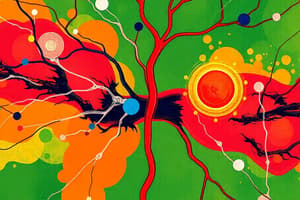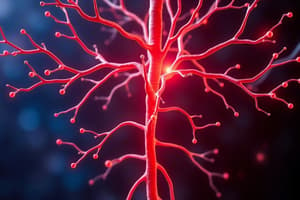Podcast
Questions and Answers
Which receptors are specifically activated by acetylcholine?
Which receptors are specifically activated by acetylcholine?
- alpha-1 and alpha-2 adrenergic receptors
- muscarinic receptors (correct)
- nicotinic receptors (correct)
- beta-1 adrenergic receptors
Which hormone is least likely to be involved in carbohydrate metabolism regulation?
Which hormone is least likely to be involved in carbohydrate metabolism regulation?
- intermedin (correct)
- glucagon
- insulin
- adrenaline
What causes a decrease in body temperature?
What causes a decrease in body temperature?
- decreased secretion of thyroid-stimulating hormone
- inhibition of sympathetic centers in the hypothalamus
- stimulation of heat receptors in the skin (correct)
- chemical thermoregulation inhibited (correct)
Which statement about hypothalamic thermoregulation centers is true?
Which statement about hypothalamic thermoregulation centers is true?
What effect does ADH have on the kidneys?
What effect does ADH have on the kidneys?
Which of the following is NOT caused by vasopressin?
Which of the following is NOT caused by vasopressin?
Which symptom is NOT typical of Basedow's disease?
Which symptom is NOT typical of Basedow's disease?
How are mechanoreceptors primarily excited?
How are mechanoreceptors primarily excited?
What is the main effect of active vitamin D3 on calcium levels in the plasma?
What is the main effect of active vitamin D3 on calcium levels in the plasma?
After abundant carbohydrate intake, which of the following metabolic processes is NOT expected to occur?
After abundant carbohydrate intake, which of the following metabolic processes is NOT expected to occur?
What neurotransmitter is secreted by neuron number 2 in the sympathetic nervous system pathway?
What neurotransmitter is secreted by neuron number 2 in the sympathetic nervous system pathway?
Which of the following statements about salivation is correct?
Which of the following statements about salivation is correct?
What physiological change is commonly associated with the stimulation of the parasympathetic nervous system?
What physiological change is commonly associated with the stimulation of the parasympathetic nervous system?
Which of the following accurately describes Somatomedin C?
Which of the following accurately describes Somatomedin C?
On the 14th day of a normal menstrual cycle, what occurs regarding the endometrium?
On the 14th day of a normal menstrual cycle, what occurs regarding the endometrium?
What hormonal changes are expected in plasma after a large dose of insulin is administered intravenously?
What hormonal changes are expected in plasma after a large dose of insulin is administered intravenously?
Which of the following substances is considered a sympathomimetic?
Which of the following substances is considered a sympathomimetic?
Which channels are involved in chemical-dependent ion transmission on the postsynaptic membrane?
Which channels are involved in chemical-dependent ion transmission on the postsynaptic membrane?
What type of fibers do the axons of preganglionic neurons belong to?
What type of fibers do the axons of preganglionic neurons belong to?
Which of the following processes does NOT occur when the sympathetic nervous system is stimulated?
Which of the following processes does NOT occur when the sympathetic nervous system is stimulated?
What effect does stimulation of the sympathetic nervous system have on the radial muscle fibers of the iris?
What effect does stimulation of the sympathetic nervous system have on the radial muscle fibers of the iris?
Which of the following is NOT a sympathetic reaction that occurs during physical or mental stress?
Which of the following is NOT a sympathetic reaction that occurs during physical or mental stress?
Where are nicotinic receptors primarily located?
Where are nicotinic receptors primarily located?
Which statement about synaptic transmission in sympathetic ganglia is true?
Which statement about synaptic transmission in sympathetic ganglia is true?
Which hormone is primarily responsible for stimulating gluconeogenesis?
Which hormone is primarily responsible for stimulating gluconeogenesis?
Which change does NOT occur in type 1 diabetes?
Which change does NOT occur in type 1 diabetes?
What is the effect of cortisol during protein metabolism?
What is the effect of cortisol during protein metabolism?
Primary hyperthyroidism is characterized by which of the following hormonal levels?
Primary hyperthyroidism is characterized by which of the following hormonal levels?
Beta-receptors activate G-proteins, which subsequently activate which enzyme?
Beta-receptors activate G-proteins, which subsequently activate which enzyme?
How does stimulation of the sympathetic nervous system affect the pupil diameter?
How does stimulation of the sympathetic nervous system affect the pupil diameter?
What effect do sympathetic nerves have on the heart rate and force of contractions?
What effect do sympathetic nerves have on the heart rate and force of contractions?
How does intense stimulation of the vagus nerve affect the heart?
How does intense stimulation of the vagus nerve affect the heart?
Which statements about gluconeogenesis are correct?
Which statements about gluconeogenesis are correct?
Which substances can effectively constrict the pupil?
Which substances can effectively constrict the pupil?
Which of the following factors can increase insulin secretion?
Which of the following factors can increase insulin secretion?
What statements about parathyroid hormone (PTH) are accurate?
What statements about parathyroid hormone (PTH) are accurate?
Which statements regarding cortisol are true?
Which statements regarding cortisol are true?
Identify the correct factors that increase calcium absorption.
Identify the correct factors that increase calcium absorption.
Which nervous system stimulation is responsible for bladder muscle contraction?
Which nervous system stimulation is responsible for bladder muscle contraction?
Which of the following statements about ADH is true?
Which of the following statements about ADH is true?
Flashcards are hidden until you start studying
Study Notes
Autonomic Nervous System: Neurotransmitters & Receptors
- Acetylcholine is a parasympathomimetic neurotransmitter, meaning it mimics the effects of the parasympathetic nervous system.
- Atropine is a parasympatholytic drug, blocking the actions of acetylcholine at muscarinic receptors.
- Aminazaine is not a parasympathomimetic.
Sympathetic Nervous System
- Adrenaline and noradrenaline are sympathomimetic neurotransmitters, stimulating the sympathetic nervous system.
- Sympathetic stimulation leads to pupil dilation, increased heart rate, and blood pressure, as well as bronchodilation.
- Insulin secretion is inhibited by sympathetic stimulation.
Neuronal Axon Types
- Preganglionic neurons of the autonomic nervous system have myelinated axons classified as type A fibers.
- Postganglionic neurons have unmyelinated axons classified as type C fibers.
Ion Channels & Synapse Transmission
- Chemically-dependent ion channels are responsible for the transmission of nerve impulses across synapses. These include sodium, calcium, potassium, and chloride channels.
- Sympathetic ganglia use nicotinic receptors for neurotransmission, with acetylcholine as the primary neurotransmitter.
- Acetylcholine binds to muscarinic receptors in parasympathetic effector organs.
Hormonal Regulation of Metabolism
- Insulin, glucagon, and thyroxine are involved in the regulation of carbohydrate metabolism, while intermedin plays a role in skin pigmentation.
- Hypothalamic thermoregulation centers control body temperature via heat production and dissipation mechanisms.
- Cortisol, thyroid hormones, and growth hormone are involved in fat metabolism, while parathyroid glands play a role in calcium and phosphate balance.
- Parathyroid hormone increases blood calcium levels by stimulating osteoclasts and decreasing calcium excretion by the kidneys.
- Vitamin D3 also increases calcium absorption in the intestines.
Effects of Hormonal Imbalances
- Basedow's disease (hyperthyroidism) is characterized by increased heart rate, thermogenesis, appetite, and oxygen consumption. The patient may show weight loss despite increased appetite.
Neurotransmitter Effects
- Norepinephrine and epinephrine can constrict the pupil by stimulating the radial muscles of the iris.
- Acetylcholine acts on the circular muscles of the iris, causing pupil constriction (miosis).
- Atropine, by blocking muscarinic receptors, would dilate the pupil.
Insulin & Glucose Metabolism
- Insulin is secreted in response to increased blood glucose levels, promoting glucose uptake and utilization by cells.
- Insulin secretion can be stimulated by various factors including beta-adrenergic stimulation and leptin.
- Gluconeogenesis, the production of glucose from non-carbohydrate sources, occurs in the liver and is stimulated by glucagon and cortisol.
- Glycogenesis, the synthesis of glycogen, is activated when cellular ATP levels are high, typically after carbohydrate intake.
- Glycogenolysis, the breakdown of glycogen, is stimulated by glucagon and epinephrine.
Impacts of Hormonal Disorders
- Diabetes mellitus type 1 is characterized by insulin deficiency, leading to hyperglycemia, osmotic diuresis, increased lipolysis, and ketone body formation.
- Cortisol increases protein breakdown, while insulin promotes protein synthesis.
Effects of Sympathetic & Parasympathetic Stimulation
- Sympathetic stimulation increases heart rate and force of contraction (positive inotropic and chronotropic effects) while parasympathetic stimulation has the opposite effect (decreases heart rate).
- Sympathetic stimulation also increases oxygen consumption by the body.
- Parasympathetic stimulation promotes energy storage and conservation.
Effects of Other Hormones
- Somatomedin C, also known as IGF-1, has insulin-like effects and is stimulated by growth hormone (GH).
- Oxytocin, released from the posterior pituitary, stimulates uterine contractions during labor and milk ejection during breastfeeding.
- ADH (vasopressin), also from the posterior pituitary, increases water reabsorption in the kidneys, leading to concentrated urine and decreased diuresis.
Summary of Important Hormones & Their Effects
- Insulin: lowers blood glucose, promotes glucose uptake and utilization, stimulates protein synthesis, inhibits lipolysis
- Glucagon: raises blood glucose, stimulates glycogenolysis, promotes gluconeogenesis
- Cortisol: increases blood glucose, stimulates gluconeogenesis, inhibits glucose uptake by cells, increases protein breakdown, influences immune function
- Growth hormone (GH): stimulates protein synthesis, promotes growth, increases lipolysis, decreases glucose uptake
- Thyroid hormones (T3 & T4): regulate metabolism, increase oxygen consumption, increase heart rate, promote growth and development
- Parathyroid hormone (PTH): increases blood calcium levels, stimulates osteoclast activity, decreases calcium excretion by the kidneys
- Vitamin D3: increases calcium absorption in the intestines, regulates bone metabolism
- Aldosterone: regulates electrolyte balance, increases sodium reabsorption in the kidneys
- ADH (vasopressin): increases water reabsorption in the kidneys, regulates blood pressure
- Oxytocin: stimulates uterine contractions and milk ejection
These study notes highlight key concepts related to the autonomic nervous system, neurotransmitters, receptors, and hormonal regulation of physiological processes. You should now have a good foundation for deeper study in this area!
Studying That Suits You
Use AI to generate personalized quizzes and flashcards to suit your learning preferences.




